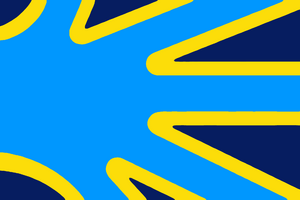Polyashi Sign Language: Difference between revisions
m (Fixed the Gabrielland symbol) |
m (→Phoneme signs) |
||
| (34 intermediate revisions by the same user not shown) | |||
| Line 1: | Line 1: | ||
{{WIP}} | {{Region icon Anteria}}{{WIP}} | ||
{{Infobox language | {{Infobox language | ||
| name = Polyashi Sign Language (P.S.L.) | | name = Polyashi Sign Language (P.S.L.) | ||
| altname = Lingua gesticulatoria | | altname = Lingua gesticulatoria Pœliacorum (L.G.P.) | ||
| nativename = [[File:Sign language L.svg|30px|link=]][[File:Sign language G.svg|40px|link=]] [[File:LGP_P_outline.png|25px|link=]] | | nativename = [[File:Sign language L.svg|30px|link=]][[File:Sign language G.svg|40px|link=]] [[File:LGP_P_outline.png|25px|link=]] | ||
| acceptance = | | acceptance = | ||
| Line 62: | Line 62: | ||
*{{flag|Krenya}} | *{{flag|Krenya}} | ||
*{{flag|Speke}} | *{{flag|Speke}} | ||
*{{flag|Tiskaiya}} | |||
*[[File:Triumvirateflag.png|link=|border|23px]] [[Triumvirate|The Triumvirate]]{{Hidden begin}} | *[[File:Triumvirateflag.png|link=|border|23px]] [[Triumvirate|The Triumvirate]]{{Hidden begin}} | ||
**{{flag|Kilowatt}} | **{{flag|Kilowatt}} | ||
| Line 108: | Line 108: | ||
| mapsize = | | mapsize = | ||
| mapalt = | | mapalt = | ||
| mapcaption = {{align|center|{{ | | mapcaption = {{align|center|{{legend|#007FFE|Areas where LGP is the official sign language}}}} | ||
| map2 = | | map2 = | ||
| mapalt2 = | | mapalt2 = | ||
| Line 123: | Line 123: | ||
| notice = IPA | | notice = IPA | ||
}} | }} | ||
'''Polyashi Sign Language''', usually called '''LGP''' ([ɛl d͡ʒiː piː] or [ɛl ɡɛː pɛː] in [[wikipedia:International Phonetic Alphabet|IPA]]) as a shortcut of ''"Lingua gesticulatoria | '''Polyashi Sign Language''', usually called '''LGP''' ([ɛl d͡ʒiː piː] or [ɛl ɡɛː pɛː] in [[wikipedia:International Phonetic Alphabet|IPA]], [[File:Sign language L.svg|15px|link=]][[File:Sign language G.svg|20px|link=]] [[File:LGP_P_outline.png|12px|link=]] in [[#Phoneme signs|LGPA]]) as a shortcut of ''"Lingua gesticulatoria Pœliacorum"'' (which is the name in [[wikipedia:Latin|Latin]]), sometimes written in other scripts: ЛГП ([[wikipedia:Cyrillic script|Govoric]]), ⲖⲄⲠ ([[wikipedia:Coptic alphabet|Protopolyash]]), ឯល្គេពេ ([[wikipedia:Khmer script|Preimeai]]) or [[File:BotoEA.png|link=|5px]][[File:BotoLS.png|link=|10px]][[File:BotoGM.png|link=|10px]][[File:Boto&L.png|link=|5px]][[File:BotoPE.png|link=|10px]][[File:Boto&A.png|link=|5px]] ([[Boto script|Boto]]) is a [[wikipedia:Sign language|sign languages]] used by deaf communities in southern and southwestern [[Thuadia]], in general areas influenced by the [[Kento-Polyash languages|Kento-Polyashi culture]]. It is a [[wikipedia:Logogram|logographic]] language with signs for most common [[wikipedia:Phoneme|phonemes]] in local languages for possible spelling of words with no set symbol. | ||
==History== | ==History== | ||
The origins of the languages are unclear, but it is expected, that the language developed in perpetua as the diverging [[Kento-Polyash languages|Kento-Polyashi tribes]] tried communicating with neighboring cultures, especially [[Mokhavic languages|Mokhavic]] and [[wikipedia:Germanic languages|Germanic]] in the southern [[Thuadia]] and [[wikipedia:Romance languages|Romance]] on the [[Anteria Triumvirate|Canterian peninsula]]. | The origins of the languages are unclear, but it is expected, that the language developed in perpetua as the diverging [[Kento-Polyash languages|Kento-Polyashi tribes]] tried communicating with neighboring cultures, especially [[Mokhavic languages|Mokhavic]] and [[wikipedia:Germanic languages|Germanic]] in the southern [[Thuadia]] and [[wikipedia:Romance languages|Romance]] on the [[Anteria Triumvirate|Canterian peninsula]]. | ||
| Line 146: | Line 146: | ||
|style=text-align:center|1905 | |style=text-align:center|1905 | ||
|style=text-align:center|1943 | |style=text-align:center|1943 | ||
|'' | |''Legislation transferred to [[Zhousheng]] | ||
|- | |- | ||
|{{flag|Bogmia}} | |{{flag|Bogmia}} | ||
|style=text-align:center|1909 | |style=text-align:center|1909 | ||
|style=text-align:center|1943 | |style=text-align:center|1943 | ||
|'' | |''Legislation transferred to [[Zhousheng]] | ||
|- | |- | ||
|{{flag|Gadorien}} | |{{flag|Gadorien}} | ||
| Line 171: | Line 171: | ||
|style=text-align:center|1924 | |style=text-align:center|1924 | ||
|style=text-align:center|1947 | |style=text-align:center|1947 | ||
|'' | |''Legislation transferred to independent [[Prei Meas]] | ||
|- | |- | ||
|[[file:BorelianKingdomFlag.png|border|link=|23px]] Colonial [[Storvan Autonomy|Storvan]] | |[[file:BorelianKingdomFlag.png|border|link=|23px]] Colonial [[Storvan Autonomy|Storvan]] | ||
|style=text-align:center|1925 | |style=text-align:center|1925 | ||
|style=text-align:center|1947 | |style=text-align:center|1947 | ||
|'' | |''Legislation transferred to independent [[Storvan Autonomy|Storvan]] | ||
|- | |- | ||
|{{flag|Qazhshava}} | |{{flag|Qazhshava}} | ||
| Line 185: | Line 185: | ||
|{{flag|Torvon}} | |{{flag|Torvon}} | ||
|style=text-align:center|1932 | |style=text-align:center|1932 | ||
|style=text-align:center|— | |||
|'' | |||
|- | |||
|{{flag|Tiskaiya}} | |||
|style=text-align:center|1935 | |||
|style=text-align:center|— | |style=text-align:center|— | ||
|'' | |'' | ||
| Line 191: | Line 196: | ||
|style=text-align:center|1943 | |style=text-align:center|1943 | ||
|style=text-align:center|2017 | |style=text-align:center|2017 | ||
|''Reaffirmation from [[Bogmia]] and [[Zhengia]], | |''Reaffirmation from [[Bogmia]] and [[Zhengia]], legislation transferred to [[Mustelaria]] | ||
|- | |- | ||
|[[file:StorvanFlag.png|border|link=|23px]] [[Storvan Autonomy|Storvan State]] | |[[file:StorvanFlag.png|border|link=|23px]] [[Storvan Autonomy|Storvan State]] | ||
|style=text-align:center|1947 | |style=text-align:center|1947 | ||
|style=text-align:center|1951 | |style=text-align:center|1951 | ||
|'' | |''Legislation transferred to [[Storvan Autonomy]] via [[Zhousheng]] | ||
|- | |- | ||
|[[File:Triumvirateflag.png|link=|border|23px]] [[Triumvirate|The Triumvirate]] | |[[File:Triumvirateflag.png|link=|border|23px]] [[Triumvirate|The Triumvirate]] | ||
| Line 215: | Line 220: | ||
|style=text-align:center|1957 | |style=text-align:center|1957 | ||
|style=text-align:center|2017 | |style=text-align:center|2017 | ||
|'' | |''Legislation language transferred to [[Mustelaria]] | ||
|- | |- | ||
|{{flag|Speke}} | |{{flag|Speke}} | ||
| Line 232: | Line 237: | ||
{{Infobox writing system | {{Infobox writing system | ||
| name = Polyashi Phonetic Manual Alphabet | | name = Polyashi Phonetic Manual Alphabet | ||
| altname = LGP Phonetic Alphabet<!-- 2ary name --> | | altname = LGP Phonetic Alphabet (LGPA)<br>[[File:Sign language L.svg|30px|link=]][[File:Sign language G.svg|40px|link=]] [[File:LGP_P_outline.png|25px|link=]] [[File:Sign_language_A.svg|24px|link=]]<!-- 2ary name --> | ||
| type = Manual<!-- (see type options below) --> | | type = Manual<!-- (see type options below) --> | ||
| qid = | | qid = | ||
| Line 265: | Line 270: | ||
| ipa-note = <!-- (set to "none" to cancel IPA warning) --> | | ipa-note = <!-- (set to "none" to cancel IPA warning) --> | ||
}} | }} | ||
There is a special phonetical sign alphabet, called the '''Polyashi Phonetic Manual Alphabet''', or simply referred to as the '''LGPA''', ([ɛl d͡ʒiː piː ɛj] or [ɛl ɡɛː pɛː ɑː] in [[wikipedia:International Phonetic Alphabet|IPA]], [[File:Sign language L.svg|15px|link=]][[File:Sign language G.svg|20px|link=]] [[File:LGP_P_outline.png|12px|link=]] [[File:Sign_language_A.svg|12px|link=]] in [[#Phoneme signs|LGPA]], shortcut for ''Linguæ gesticulatoriarum Pœliacorum Abecedarium''). | |||
The language has special signs for: | The language has special signs for: | ||
*[[wikipedia:Consonant|Consonants]]: /b/, /p/, /t͡s ~ ʈ͡s/, /t͡ʃ ~ t͡ɕ ~ t͡ʂ/, /d͡z ~ ɖ͡z/, /d͡ʒ ~ d͡ʑ ~ d͡ʐ/, /ʃ ~ ɕ ~ ʂ/, /ʒ ~ ʑ ~ ʐ/, /d ~ ɖ/, /t ~ ʈ/, /tʲ~ c/, /dʲ ~ ɟ/, /h ~ ɦ/, /x ~ χ/, /z ~ zʲ/, /s ~ sʲ/, /ð ~ θ/, /ɡ ~ ɢ/, /k/, /q/, /v ~ β/, /f ~ ɸ/, /r ~ ɾ/, /ʀ ~ ɹ ~ ʁ/, /m/, /n/, /ŋ/, /nʲ ~ ɲ/, /l ~ ɫ ~ ʟ/, /ʎ ~ lʲ ~ ȴ/, /ɰ ~ w/, /j ~ ʝ/ | *[[wikipedia:Consonant|Consonants]]: /b/, /p/, /t͡s ~ ʈ͡s/, /t͡ʃ ~ t͡ɕ ~ t͡ʂ/, /d͡z ~ ɖ͡z/, /d͡ʒ ~ d͡ʑ ~ d͡ʐ/, /ʃ ~ ɕ ~ ʂ/, /ʒ ~ ʑ ~ ʐ/, /d ~ ɖ/, /t ~ ʈ/, /tʲ~ c/, /dʲ ~ ɟ/, /h ~ ɦ/, /x ~ χ/, /z ~ zʲ/, /s ~ sʲ/, /ð ~ θ/, /ɡ ~ ɢ/, /k/, /q/, /v ~ β/, /f ~ ɸ/, /r ~ ɾ/, /ʀ ~ ɹ ~ ʁ/, /m/, /n/, /ŋ/, /nʲ ~ ɲ/, /l ~ ɫ ~ ʟ/, /ʎ ~ lʲ ~ ȴ/, /ɰ ~ w/, /j ~ ʝ/ | ||
| Line 274: | Line 281: | ||
|colspan="10"|All signs can be done with a single hand (in this example right hand, left can be used also) | |colspan="10"|All signs can be done with a single hand (in this example right hand, left can be used also) | ||
|- | |- | ||
|style="border-right:1px dashed #A2A9B1;“|[[File:LGP-B.jpg| | |style="border-right:1px dashed #A2A9B1; padding:0px; background: #003399;“|[[File:LGP-B.jpg|100px]] | ||
|style="border-left:1px dashed #A2A9B1;“|[[File:LGP-P.jpg| | |style="border-left:1px dashed #A2A9B1; padding:0px; background: #003399;“|[[File:LGP-P.jpg|100px]] | ||
|style="border-right:1px dashed #A2A9B1;“|[[File:LGP-D.jpg| | |style="border-right:1px dashed #A2A9B1; padding:0px; background: #003399;“|[[File:LGP-D.jpg|100px]] | ||
|style="border-left:1px dashed #A2A9B1;“|[[File:LGP-T.jpg| | |style="border-left:1px dashed #A2A9B1; padding:0px; background: #003399;“|[[File:LGP-T.jpg|100px]] | ||
|style="border-right:1px dashed #A2A9B1;“|[[File:LGP-DJ.jpg| | |style="border-right:1px dashed #A2A9B1; padding:0px; background: #003399;“|[[File:LGP-DJ.jpg|100px]] | ||
|style="border-left:1px dashed #A2A9B1;“|[[File:LGP-C.jpg| | |style="border-left:1px dashed #A2A9B1; padding:0px; background: #003399;“|[[File:LGP-C.jpg|100px]] | ||
|style="border-right:1px dashed #A2A9B1;“|[[File:LGP-G.jpg| | |style="border-right:1px dashed #A2A9B1; padding:0px; background: #003399;“|[[File:LGP-G.jpg|100px]] | ||
|style="border-left:1px dashed #A2A9B1;“|[[File:LGP-K.jpg| | |style="border-left:1px dashed #A2A9B1; padding:0px; background: #003399;“|[[File:LGP-K.jpg|100px]] | ||
|[[File:LGP-Q.jpg| | |style="padding:0px; background: #003399;"|[[File:LGP-Q.jpg|100px]] | ||
|[[File:LGP-TH.jpg| | |style="padding:0px; background: #003399;"|[[File:LGP-TH.jpg|100px]] | ||
|- | |- | ||
|bgcolor=#F5F5F5 style="border-right:1px dashed #A2A9B1;“|'''/[[wikipedia:Voiced bilabial plosive|b]]/ | |bgcolor=#F5F5F5 style="border-right:1px dashed #A2A9B1;“|'''/[[wikipedia:Voiced bilabial plosive|b]]/ | ||
| Line 296: | Line 303: | ||
|bgcolor=#F5F5F5|'''/[[wikipedia:Voiced dental fricative|ð]] ~ [[wikipedia:Voiceless dental fricative|θ]]/ | |bgcolor=#F5F5F5|'''/[[wikipedia:Voiced dental fricative|ð]] ~ [[wikipedia:Voiceless dental fricative|θ]]/ | ||
|- | |- | ||
|[[File:LGP-M.jpg| | |style="padding:0px; background: #003399;"|[[File:LGP-M.jpg|100px]] | ||
|[[File:LGP-N.jpg| | |style="padding:0px; background: #003399;"|[[File:LGP-N.jpg|100px]] | ||
|[[File:LGP-NJ.jpg| | |style="padding:0px; background: #003399;"|[[File:LGP-NJ.jpg|100px]] | ||
|[[File:LGP-NG.jpg| | |style="padding:0px; background: #003399;"|[[File:LGP-NG.jpg|100px]] | ||
|[[File:LGP-LJ.jpg| | |style="padding:0px; background: #003399;"|[[File:LGP-LJ.jpg|100px]] | ||
|[[File:LGP-L.jpg| | |style="padding:0px; background: #003399;"|[[File:LGP-L.jpg|100px]] | ||
|[[File:LGP-RJ.jpg| | |style="padding:0px; background: #003399;"|[[File:LGP-RJ.jpg|100px]] | ||
|[[File:LGP-R.jpg| | |style="padding:0px; background: #003399;"|[[File:LGP-R.jpg|100px]] | ||
|[[File:LGP-J.jpg| | |style="padding:0px; background: #003399;"|[[File:LGP-J.jpg|100px]] | ||
|[[File:LGP-W.jpg| | |style="padding:0px; background: #003399;"|[[File:LGP-W.jpg|100px]] | ||
|- | |- | ||
|bgcolor=#F5F5F5|'''/[[wikipedia:Voiced bilabial nasal|m]]/ | |bgcolor=#F5F5F5|'''/[[wikipedia:Voiced bilabial nasal|m]]/ | ||
| Line 318: | Line 325: | ||
|bgcolor=#F5F5F5|'''/[[wikipedia:Voiced velar approximant|ɰ]] ~ [[wikipedia:Voiced labialized-velar approximant|w]]/ | |bgcolor=#F5F5F5|'''/[[wikipedia:Voiced velar approximant|ɰ]] ~ [[wikipedia:Voiced labialized-velar approximant|w]]/ | ||
|- | |- | ||
|style="border-right:1px dashed #A2A9B1;“|[[File:LGP-DZ.jpg| | |style="border-right:1px dashed #A2A9B1; padding:0px; background: #003399;“|[[File:LGP-DZ.jpg|100px]] | ||
|style="border-left:1px dashed #A2A9B1;“|[[File:LGP-TS.jpg| | |style="border-left:1px dashed #A2A9B1; padding:0px; background: #003399;“|[[File:LGP-TS.jpg|100px]] | ||
|style="border-right:1px dashed #A2A9B1;“|[[File:LGP-DZX.jpg| | |style="border-right:1px dashed #A2A9B1; padding:0px; background: #003399;“|[[File:LGP-DZX.jpg|100px]] | ||
|style="border-left:1px dashed #A2A9B1;“|[[File:LGP-TSX.jpg| | |style="border-left:1px dashed #A2A9B1; padding:0px; background: #003399;“|[[File:LGP-TSX.jpg|100px]] | ||
|style="border-right:1px dashed #A2A9B1;“|[[File:LGP-Z.jpg| | |style="border-right:1px dashed #A2A9B1; padding:0px; background: #003399;“|[[File:LGP-Z.jpg|100px]] | ||
|style="border-left:1px dashed #A2A9B1;“|[[File:LGP-S.jpg| | |style="border-left:1px dashed #A2A9B1; padding:0px; background: #003399;“|[[File:LGP-S.jpg|100px]] | ||
|style="border-right:1px dashed #A2A9B1;“|[[File:LGP-ZX.jpg| | |style="border-right:1px dashed #A2A9B1; padding:0px; background: #003399;“|[[File:LGP-ZX.jpg|100px]] | ||
|style="border-left:1px dashed #A2A9B1;“|[[File:LGP-SX.jpg| | |style="border-left:1px dashed #A2A9B1; padding:0px; background: #003399;“|[[File:LGP-SX.jpg|100px]] | ||
|style="border-right:1px dashed #A2A9B1;“|[[File:LGP-V.jpg| | |style="border-right:1px dashed #A2A9B1; padding:0px; background: #003399;“|[[File:LGP-V.jpg|100px]] | ||
|style="border-left:1px dashed #A2A9B1;“|[[File:LGP-F.jpg| | |style="border-left:1px dashed #A2A9B1; padding:0px; background: #003399;“|[[File:LGP-F.jpg|100px]] | ||
|- | |- | ||
|bgcolor=#F5F5F5 style="border-right:1px dashed #A2A9B1;“|'''/[[wikipedia:Voiced alveolar affricate|d͡z]] ~ [[wikipedia:Voiced retroflex plosive|ɖ]]͡[[wikipedia:Voiced alveolar fricative|z]]/ | |bgcolor=#F5F5F5 style="border-right:1px dashed #A2A9B1;“|'''/[[wikipedia:Voiced alveolar affricate|d͡z]] ~ [[wikipedia:Voiced retroflex plosive|ɖ]]͡[[wikipedia:Voiced alveolar fricative|z]]/ | ||
| Line 340: | Line 347: | ||
|bgcolor=#F5F5F5 style="border-left:1px dashed #A2A9B1;“|'''/[[wikipedia:Voiceless labiodental fricative|f]] ~ [[wikipedia:Voiceless bilabial fricative|ɸ]]/ | |bgcolor=#F5F5F5 style="border-left:1px dashed #A2A9B1;“|'''/[[wikipedia:Voiceless labiodental fricative|f]] ~ [[wikipedia:Voiceless bilabial fricative|ɸ]]/ | ||
|- | |- | ||
|[[File:LGP-H.jpg| | |style="padding:0px; background: #003399;"|[[File:LGP-H.jpg|100px]] | ||
|[[File:LGP-X.jpg| | |style="padding:0px; background: #003399;"|[[File:LGP-X.jpg|100px]] | ||
|[[File:LGP-A.jpg| | |style="padding:0px; background: #003399;"|[[File:LGP-A.jpg|100px]] | ||
|[[File:LGP-E.jpg| | |style="padding:0px; background: #003399;"|[[File:LGP-E.jpg|100px]] | ||
|[[File:LGP-AE.jpg| | |style="padding:0px; background: #003399;"|[[File:LGP-AE.jpg|100px]] | ||
|[[File:LGP-O.jpg| | |style="padding:0px; background: #003399;"|[[File:LGP-O.jpg|100px]] | ||
|[[File:LGP-I.jpg| | |style="padding:0px; background: #003399;"|[[File:LGP-I.jpg|100px]] | ||
|[[File:LGP-U.jpg| | |style="padding:0px; background: #003399;"|[[File:LGP-U.jpg|100px]] | ||
|[[File:LGP-Y.jpg| | |style="padding:0px; background: #003399;"|[[File:LGP-Y.jpg|100px]] | ||
|[[File:LGP-OE.jpg| | |style="padding:0px; background: #003399;"|[[File:LGP-OE.jpg|100px]] | ||
|- | |- | ||
|bgcolor=#F5F5F5|'''/[[wikipedia:Voiceless glottal fricative|h]] ~ [[wikipedia:Voiced glottal fricative|ɦ]]/ | |bgcolor=#F5F5F5|'''/[[wikipedia:Voiceless glottal fricative|h]] ~ [[wikipedia:Voiced glottal fricative|ɦ]]/ | ||
| Line 362: | Line 369: | ||
|bgcolor=#F5F5F5|'''/[[wikipedia:Close-mid front rounded vowel|ø]] ~ [[wikipedia:Open-mid front rounded vowel|œ]]/ | |bgcolor=#F5F5F5|'''/[[wikipedia:Close-mid front rounded vowel|ø]] ~ [[wikipedia:Open-mid front rounded vowel|œ]]/ | ||
|- | |- | ||
|[[File:LGP-1.jpg| | |style="padding:0px; background: #003399;"|[[File:LGP-1.jpg|100px]] | ||
|[[File:LGP-2.jpg| | |style="padding:0px; background: #003399;"|[[File:LGP-2.jpg|100px]] | ||
|[[File:LGP-3.jpg| | |style="padding:0px; background: #003399;"|[[File:LGP-3.jpg|100px]] | ||
|[[File:LGP-4.jpg| | |style="padding:0px; background: #003399;"|[[File:LGP-4.jpg|100px]] | ||
|[[File:LGP-5.jpg| | |style="padding:0px; background: #003399;"|[[File:LGP-5.jpg|100px]] | ||
|[[File:LGP-6.jpg| | |style="padding:0px; background: #003399;"|[[File:LGP-6.jpg|100px]] | ||
|[[File:LGP-7.jpg| | |style="padding:0px; background: #003399;"|[[File:LGP-7.jpg|100px]] | ||
|[[File:LGP-8.jpg| | |style="padding:0px; background: #003399;"|[[File:LGP-8.jpg|100px]] | ||
|[[File:LGP-9.jpg| | |style="padding:0px; background: #003399;"|[[File:LGP-9.jpg|100px]] | ||
|[[File:LGP-0.jpg| | |style="padding:0px; background: #003399;"|[[File:LGP-0.jpg|100px]] | ||
|- | |- | ||
|bgcolor=#F5F5F5|'''1 | |bgcolor=#F5F5F5|'''1 | ||
| Line 383: | Line 390: | ||
|bgcolor=#F5F5F5|'''9 | |bgcolor=#F5F5F5|'''9 | ||
|bgcolor=#F5F5F5|'''0 ~ 10 | |bgcolor=#F5F5F5|'''0 ~ 10 | ||
<!--|- | |} | ||
|style=" | |||
|style=" | This alphabet is of course linked to the language of origin of the speaker and can be realistically used only in communication between two people of the same nationality. | ||
|style=" | |||
|style=" | ==Pronouns== | ||
|style=" | <!--The language still has preserved remnants of [[wikipedia:Dual (grammatical number)|dual]] in the form of strictly [[wikipedia:Clusivity|inclusive]] we (That is "I and you, but not anybody else"), which is considered to be the 5th person plural (4th person is exclusive we)--> | ||
|style=" | The language uses the 4th person in plural for the [[wikipedia:Clusivity|exclusive]] we. | ||
|style=" | {| class="wikitable" style="text-align: center;" | ||
|style=" | !rowspan="2"|Figure !!colspan="3"|Includes !!rowspan="2"|Name | ||
|style=" | |- | ||
|style=" | !Speaker !!Listener !!Others | ||
|- | |||
!''0th Person'' | |||
|style="background:#EF4040"|<span style="color: #A80000">'''NO'''</span> | |||
|style="background:#EF4040"|<span style="color: #A80000">'''NO'''</span> | |||
|style="background:#EF4040"|<span style="color: #A80000">'''NO'''</span> | |||
|Nobody | |||
|- | |||
!rowspan="3"|1st person | |||
|style="background:#74FF60"|<span style="color: #108000">'''YES'''</span> | |||
|style="background:#EF4040"|<span style="color: #A80000">'''NO'''</span> | |||
|style="background:#EF4040"|<span style="color: #A80000">'''NO'''</span> | |||
|I | |||
|- | |||
|style="background:#74FF60"|<span style="color: #108000">'''YES'''</span> | |||
|style="background:#74FF60"|<span style="color: #108000">'''YES'''</span> | |||
|style="background:#74FF60"|<span style="color: #108000">'''YES'''</span> | |||
|rowspan="2"|We ([[wikipedia:Clusivity|inclus.]]) | |||
|- | |||
|style="background:#74FF60"|<span style="color: #108000">'''YES'''</span> | |||
|style="background:#74FF60"|<span style="color: #108000">'''YES'''</span> | |||
|style="background:#EF4040"|<span style="color: #A80000">'''NO'''</span> | |||
|- | |||
!rowspan="2"|2nd person | |||
|style="background:#EF4040"|<span style="color: #A80000">'''NO'''</span> | |||
|style="background:#74FF60"|<span style="color: #108000">'''YES'''</span> | |||
|style="background:#EF4040"|<span style="color: #A80000">'''NO'''</span> | |||
|You (sg.) | |||
|- | |||
|style="background:#EF4040"|<span style="color: #A80000">'''NO'''</span> | |||
|style="background:#74FF60"|<span style="color: #108000">'''YES'''</span> | |||
|style="background:#74FF60"|<span style="color: #108000">'''YES'''</span> | |||
|You (pl.) | |||
|- | |||
!3rd person | |||
|style="background:#EF4040"|<span style="color: #A80000">'''NO'''</span> | |||
|style="background:#EF4040"|<span style="color: #A80000">'''NO'''</span> | |||
|style="background:#74FF60"|<span style="color: #108000">'''YES'''</span> | |||
|He/She/It/They | |||
|- | |||
!4th person | |||
|style="background:#74FF60"|<span style="color: #108000">'''YES'''</span> | |||
|style="background:#EF4040"|<span style="color: #A80000">'''NO'''</span> | |||
|style="background:#74FF60"|<span style="color: #108000">'''YES'''</span> | |||
|We ([[wikipedia:Clusivity|exclus.]]) | |||
|- | |||
<!--!5th person | |||
|style="background:#74FF60"|<span style="color: #108000">'''YES'''</span> | |||
|style="background:#74FF60"|<span style="color: #108000">'''YES'''</span> | |||
|style="background:#EF4040"|<span style="color: #A80000">'''NO'''</span> | |||
|We ([[wikipedia:Clusivity|str. incl.]])--> | |||
|} | |||
{| class="wikitable" style="text-align: center;" | |||
!colspan="3"|Singular !!colspan="4"|Plural !!colspan="5"|Other | |||
|- | |||
!I !!You !!They !!We (incl.) !!You !!They !!We (excl.) <!--!!We (str. in.) -->!!None !!Every !!Any !!Some !!Who | |||
|- | |||
|[[File:LGP-1sg.jpg|100px]] | |||
|[[File:LGP-2sg.jpg|100px]] | |||
|[[File:LGP-3sg.jpg|100px]] | |||
|[[File:LGP-1pl.jpg|100px]] | |||
|[[File:LGP-2pl.jpg|100px]] | |||
|[[File:LGP-3pl.jpg|100px]] | |||
|[[File:LGP-4pl.jpg|100px]] | |||
<!--|[[File:LGP-5pl.jpg|100px]]--> | |||
|[[File:LGP-noper.jpg|100px]] | |||
|[[File:LGP-allper.jpg|100px]] | |||
|[[File:LGP-sbper.jpg|100px]] | |||
|[[File:LGP-anyper.jpg|100px]] | |||
|[[File:LGP-whoper.jpg|100px]] | |||
|- | |- | ||
|bgcolor=#F5F5F5 | |bgcolor=#F5F5F5|'''1.sg ||bgcolor=#F5F5F5|'''2.sg ||bgcolor=#F5F5F5|'''3.sg ||bgcolor=#F5F5F5|'''1.pl ||bgcolor=#F5F5F5|'''2.pl ||bgcolor=#F5F5F5|'''3.pl ||bgcolor=#F5F5F5|'''4.pl ||bgcolor=#F5F5F5|'''A.sg ||bgcolor=#F5F5F5|'''A.pl ||bgcolor=#F5F5F5|'''?.sg ||bgcolor=#F5F5F5|'''?.pl ||bgcolor=#F5F5F5|'''Ques. <!--||bgcolor=#F5F5F5|'''5.pl--> | ||
|bgcolor=#F5F5F5 | |||
|bgcolor=#F5F5F5 | |||
|bgcolor=#F5F5F5 | |||
|bgcolor=#F5F5F5 | |||
|bgcolor=#F5F5F5 | |||
|bgcolor=#F5F5F5 | |||
|bgcolor=#F5F5F5 | |||
|bgcolor=#F5F5F5 | |||
|bgcolor=#F5F5F5 | |||
|} | |} | ||
{| class="wikitable" style="text-align: center;" | |||
!colspan="2" rowspan="2"|[[wikipedia:Clusivity|Clusivity]] chart !!colspan="2"|Does it include the listener? | |||
|- | |||
!YES !!NO | |||
|- | |||
!rowspan="2"|Does it include<br>the speaker? | |||
!YES | |||
|Inclusive We ||Exclusive We | |||
|- | |||
!NO | |||
|You ||They | |||
|} | |||
==Word Order== | |||
The LGP has a heavily controlled [[wikipedia:Word order|word order]], which works as following: | |||
[[wikipedia:Grammatical modifier|MODIFIERS]] — <small>''Further adverbials''</small> — <big>'''[[wikipedia:Subject (grammar)|SUBJECT]]'''</big> — [[wikipedia:Adverbial|ADVERBIALS]] — POSSIBLE NEGATION — <big>'''[[wikipedia:Predicate (grammar)|PREDICATE]]'''</big> — POSSIBLE QUESTION — <small>''Object modifiers''</small> — [[wikipedia:Object (grammar)|OBJECTS]] | |||
For example, the [[wikipedia:Pangram|pangram]] "The quick brown fox jumps over a lazy dog" would have the order of "Quick - brown - fox - to jump - lazy - over dog" | |||
If we were to modify the sentence to "The very quick light brown fox doesn't steadily jump over a somewhat lazy dog", we would have to follow the word order to: "Quick - very - brown - light - fox - to jump - steadily - not - lazy - somewhat - over dog" | |||
{{Template:Anteria languages navbox}} | |||
{{Template:Anteria info pages}} | {{Template:Anteria info pages}} | ||
[[Category:Languages in Anteria]] | |||
[[Category:Anteria]] | [[Category:Anteria]] | ||
[[Category:Kento-Polyash languages]] | |||
Latest revision as of 11:43, 7 August 2021
This article is incomplete because it is pending further input from participants, or it is a work-in-progress by one author. Please comment on this article's talk page to share your input, comments and questions. Note: To contribute to this article, you may need to seek help from the author(s) of this page. |
| Polyashi Sign Language (P.S.L.) | |
|---|---|
| Lingua gesticulatoria Pœliacorum (L.G.P.) | |
 People communicating using the LGP | |
| Pronunciation | [ɛl d͡ʒiː piː] |
| Native to | Countries influenced by the Kento-Polyashi culture |
| Region | Southern and Southwestern Thuadia |
Native speakers | L1: ~3,000,000 L2: ~2,500,000 FL: ~5,000,000 |
| Official status | |
Official language in |
|
| Language codes | |
| ISO 639-1 | LGP |
| ISO 639-2 | LGP |
| ISO 639-3 | LGP |
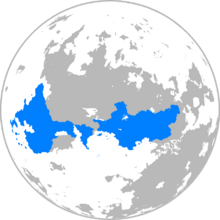 Areas where LGP is the official sign language | |
Polyashi Sign Language, usually called LGP ([ɛl d͡ʒiː piː] or [ɛl ɡɛː pɛː] in IPA,
![]() in LGPA) as a shortcut of "Lingua gesticulatoria Pœliacorum" (which is the name in Latin), sometimes written in other scripts: ЛГП (Govoric), ⲖⲄⲠ (Protopolyash), ឯល្គេពេ (Preimeai) or
in LGPA) as a shortcut of "Lingua gesticulatoria Pœliacorum" (which is the name in Latin), sometimes written in other scripts: ЛГП (Govoric), ⲖⲄⲠ (Protopolyash), ឯល្គេពេ (Preimeai) or ![]()
![]()
![]()
![]() File:BotoPE.png
File:BotoPE.png![]() (Boto) is a sign languages used by deaf communities in southern and southwestern Thuadia, in general areas influenced by the Kento-Polyashi culture. It is a logographic language with signs for most common phonemes in local languages for possible spelling of words with no set symbol.
(Boto) is a sign languages used by deaf communities in southern and southwestern Thuadia, in general areas influenced by the Kento-Polyashi culture. It is a logographic language with signs for most common phonemes in local languages for possible spelling of words with no set symbol.
History
The origins of the languages are unclear, but it is expected, that the language developed in perpetua as the diverging Kento-Polyashi tribes tried communicating with neighboring cultures, especially Mokhavic and Germanic in the southern Thuadia and Romance on the Canterian peninsula.
The first recorded mention of the language comes from present-day Zhousheng, where a local Proto-Bogmian Catholic priest during the times of early Kaȝin reformation complained, that a Kaȝin priest used a sign language among local Tghok populace to spread their belief onto the pagan populace rather than using a language (there was a strong belief in the Gift of Tongues at that time).
First codified form can be found in present day Kentalis from 1650, where a community of Ereskans codified a standart for communication with a local field hospital, where a lot of people were shellshocked and temporairly lost their hearing because of a loud explosion in their proximity.
The language got international codification only by the mid of 18th century after the establishment of the Empire of Three Kings, where local deaf communities in Gadorieni states, the Empire of Three Kings, western parts of Prei Meas, southern Qazhshava and Speke started coordinating in creating a sign lingua france for possible cross-border communication. Although the first codified language was incoherrent to many deaf communities, further changes allowed its development to the extend in which it exists today.
On the 1912 congress (shortly after the Great War), communities from 16 countries codified the unified language as the official sign language of their respective countries, which started to be educated on deaf schools.
First country to officially declare the codified LGP as an official sign language was Zhengia in 1905.
| Country | Official | Cancelled | Note |
|---|---|---|---|
| 1905 | 1943 | Legislation transferred to Zhousheng | |
| 1909 | 1943 | Legislation transferred to Zhousheng | |
| 1910 | — | ||
| 1916 | — | ||
| 1923 | — | ||
| 1924 | 1947 | Legislation transferred to independent Prei Meas | |
| 1925 | 1947 | Legislation transferred to independent Storvan | |
| 1926 | — | ||
| 1932 | — | ||
| 1935 | — | ||
| 1943 | 2017 | Reaffirmation from Bogmia and Zhengia, legislation transferred to Mustelaria | |
| 1947 | 1951 | Legislation transferred to Storvan Autonomy via Zhousheng | |
| 1948 | — | ||
| 1951 | 1975 | Cancelled by the communists during the civil war, reinstated after the war ended | |
| 1977 | — | ||
| 1957 | 2017 | Legislation language transferred to Mustelaria | |
| 1961 | — | ||
| 2017 | — | Reaffirmation from Zhousheng and Monte Blanco |
Introduction
TBA
Phoneme signs
| Polyashi Phonetic Manual Alphabet LGP Phonetic Alphabet (LGPA) | |
|---|---|
 Symbol for /a ~ ɑ/ as displayed on a 1905 cover of a book focusing on the topic (in Prybournian) | |
| Type | Manual
|
| Languages | Polyashi Sign Language |
| Creator | 4th Southern Thuadian Congress of the Deaf (standardization) |
| Created | ~1810 |
| Published | ~1905
|
Parent systems | Polyash sign pidgin
|
There is a special phonetical sign alphabet, called the Polyashi Phonetic Manual Alphabet, or simply referred to as the LGPA, ([ɛl d͡ʒiː piː ɛj] or [ɛl ɡɛː pɛː ɑː] in IPA,
![]()
in LGPA, shortcut for Linguæ gesticulatoriarum Pœliacorum Abecedarium).
The language has special signs for:
- Consonants: /b/, /p/, /t͡s ~ ʈ͡s/, /t͡ʃ ~ t͡ɕ ~ t͡ʂ/, /d͡z ~ ɖ͡z/, /d͡ʒ ~ d͡ʑ ~ d͡ʐ/, /ʃ ~ ɕ ~ ʂ/, /ʒ ~ ʑ ~ ʐ/, /d ~ ɖ/, /t ~ ʈ/, /tʲ~ c/, /dʲ ~ ɟ/, /h ~ ɦ/, /x ~ χ/, /z ~ zʲ/, /s ~ sʲ/, /ð ~ θ/, /ɡ ~ ɢ/, /k/, /q/, /v ~ β/, /f ~ ɸ/, /r ~ ɾ/, /ʀ ~ ɹ ~ ʁ/, /m/, /n/, /ŋ/, /nʲ ~ ɲ/, /l ~ ɫ ~ ʟ/, /ʎ ~ lʲ ~ ȴ/, /ɰ ~ w/, /j ~ ʝ/
- Vowels: /a ~ ɑ/, /ɛ ~ e/, /æ ~ ə ~ ɤ/, /ɔ ~ o/, /i ~ ɪ/, /ʊ ~ u ~ ʏ/, /ɨ ~ y/, /ø ~ œ/
Which are used for spelling untraditional words, shortcuts, and names, that do not have a classical symbol, or which are not understood by the other speaker.
| Signs for classical phonemes and numbers | |||||||||
|---|---|---|---|---|---|---|---|---|---|
| All signs can be done with a single hand (in this example right hand, left can be used also) | |||||||||
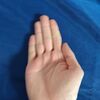
|
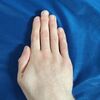
|

|
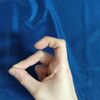
|
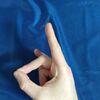
|

|
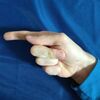
|

|

|
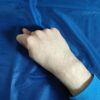
|
| /b/ | /p/ | /d ~ ɖ/ | /t ~ ʈ/ | /dʲ ~ ɟ/ | /tʲ ~ c/ | /ɡ ~ ɢ/ | /k/ | /q/ | /ð ~ θ/ |
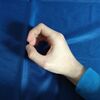
|
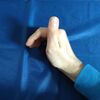
|

|

|

|

|
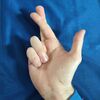
|
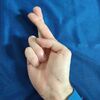
|
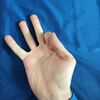
|
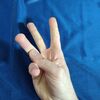
|
| /m/ | /n/ | /nʲ ~ ɲ/ | /ŋ/ | /ʎ ~ lʲ ~ ȴ/ | /l ~ ɫ ~ ʟ/ | /ʀ ~ ɹ ~ ʁ/ | /r ~ ɾ/ | /j ~ ʝ/ | /ɰ ~ w/ |

|

|

|
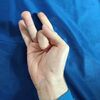
|

|

|

|
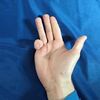
|
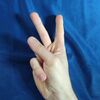
|
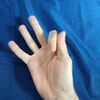
|
| /d͡z ~ ɖ͡z/ | /t͡s ~ ʈ͡s/ | /d͡ʒ ~ d͡ʑ/ | /t͡ʃ ~ t͡ɕ/ | /z ~ zʲ/ | /s ~ sʲ/ | /ʒ ~ ʑ ~ ʐ/ | /ʃ ~ ɕ ~ ʂ/ | /v ~ β/ | /f ~ ɸ/ |
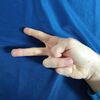
|
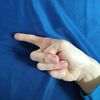
|
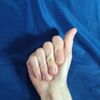
|
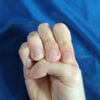
|

|
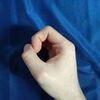
|
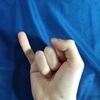
|
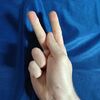
|
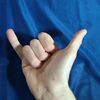
|
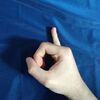
|
| /h ~ ɦ/ | /x ~ χ/ | /a ~ ɑ ~ ɒ/ | /ɛ ~ e/ | /æ ~ ə ~ ɤ/ | /ɔ ~ o/ | /i ~ ɪ/ | /ʊ ~ u ~ ʏ/ | /ɨ ~ y/ | /ø ~ œ/ |
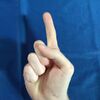
|

|
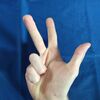
|
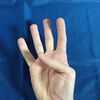
|
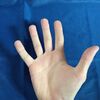
|
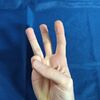
|

|
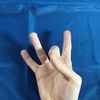
|
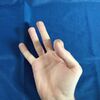
|

|
| 1 | 2 | 3 | 4 | 5 | 6 | 7 | 8 | 9 | 0 ~ 10 |
This alphabet is of course linked to the language of origin of the speaker and can be realistically used only in communication between two people of the same nationality.
Pronouns
The language uses the 4th person in plural for the exclusive we.
| Figure | Includes | Name | ||
|---|---|---|---|---|
| Speaker | Listener | Others | ||
| 0th Person | NO | NO | NO | Nobody |
| 1st person | YES | NO | NO | I |
| YES | YES | YES | We (inclus.) | |
| YES | YES | NO | ||
| 2nd person | NO | YES | NO | You (sg.) |
| NO | YES | YES | You (pl.) | |
| 3rd person | NO | NO | YES | He/She/It/They |
| 4th person | YES | NO | YES | We (exclus.) |
| Singular | Plural | Other | |||||||||
|---|---|---|---|---|---|---|---|---|---|---|---|
| I | You | They | We (incl.) | You | They | We (excl.) | None | Every | Any | Some | Who |
| File:LGP-1sg.jpg | File:LGP-2sg.jpg | File:LGP-3sg.jpg | File:LGP-1pl.jpg | File:LGP-2pl.jpg | File:LGP-3pl.jpg | File:LGP-4pl.jpg | File:LGP-noper.jpg | File:LGP-allper.jpg | File:LGP-sbper.jpg | File:LGP-anyper.jpg | File:LGP-whoper.jpg |
| 1.sg | 2.sg | 3.sg | 1.pl | 2.pl | 3.pl | 4.pl | A.sg | A.pl | ?.sg | ?.pl | Ques. |
| Clusivity chart | Does it include the listener? | ||
|---|---|---|---|
| YES | NO | ||
| Does it include the speaker? |
YES | Inclusive We | Exclusive We |
| NO | You | They | |
Word Order
The LGP has a heavily controlled word order, which works as following:
MODIFIERS — Further adverbials — SUBJECT — ADVERBIALS — POSSIBLE NEGATION — PREDICATE — POSSIBLE QUESTION — Object modifiers — OBJECTS
For example, the pangram "The quick brown fox jumps over a lazy dog" would have the order of "Quick - brown - fox - to jump - lazy - over dog"
If we were to modify the sentence to "The very quick light brown fox doesn't steadily jump over a somewhat lazy dog", we would have to follow the word order to: "Quick - very - brown - light - fox - to jump - steadily - not - lazy - somewhat - over dog"
